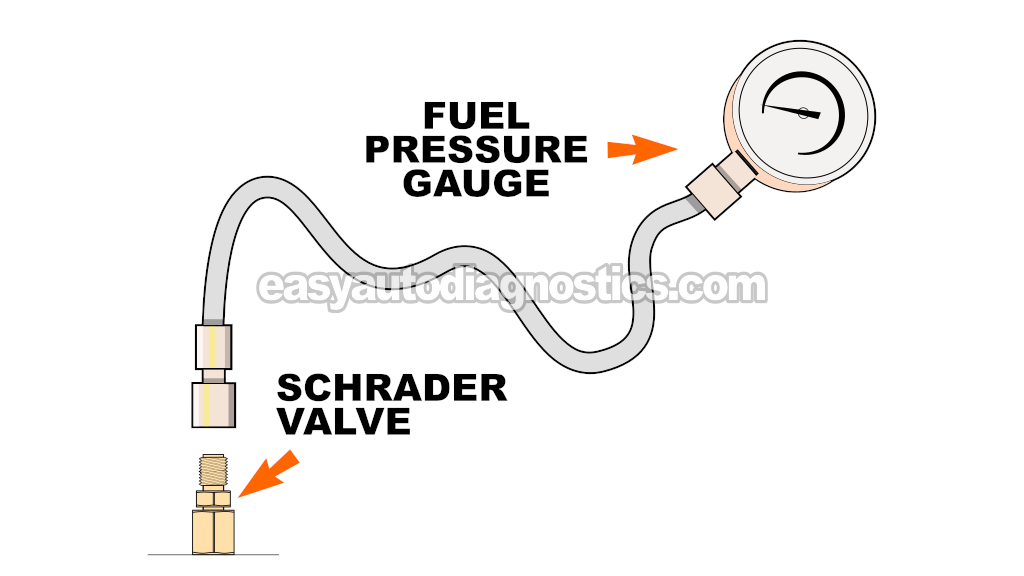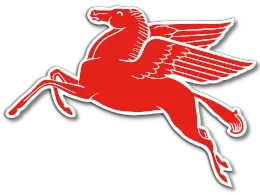
Ford has made it easy to test the fuel pump on your 4.2L V6 equipped F150 or F250. This is due to the fact that Ford installed a Schrader valve on the fuel injector rail. It's to this Schrader valve that you and I can connect a fuel pressure gauge to and check fuel pressure.
Of course, testing a lack of fuel can be done in several ways. In this tutorial, I'll present to you the two most common: Using starting fluid and using a fuel pressure gauge.
Contents of this tutorial:
- Symptoms Of A Bad Fuel Pump.
- Where To Buy A Fuel Pressure Test Gauge.
- Fuel Pressure Specifications.
- TEST 1: Checking Fuel Pressure With A Fuel Pressure Gauge.
- TEST 2: Using Starting Fluid To Confirm Lack Of Fuel.
- Fuel Pump Inertia Switch Check.
- Where To Buy The Fuel Pump And Save.
- More 4.2L Ford F150 And F250 Diagnostic Tutorials.
![]() You can find this tutorial in Spanish here: Cómo Probar La Bomba De Gasolina (4.2L Ford E150, E250, F150) (at: autotecnico-online.com).
You can find this tutorial in Spanish here: Cómo Probar La Bomba De Gasolina (4.2L Ford E150, E250, F150) (at: autotecnico-online.com).
APPLIES TO: This tutorial applies to the following vehicles:
- 4.2L V6 Ford F150: 1997, 1998, 1999, 2000, 2001, 2002, 2003.
- 4.2L V6 Ford F250: 1998.
E-SERIES VANS: The fuel pump test tutorial for the 1997-2003 4.2L V6 Ford E150/E250 vans can be found here:
- How To Test The Fuel Pump (1997-2000 4.2L V6 Ford E150, E250) (at: troubleshootmyvehicle.com)
- How To Test The Fuel Pump (2001-2003 4.2L V6 Ford E150, E250) (at: troubleshootmyvehicle.com)
Symptoms Of A Bad Fuel Pump
Fuel pump failures fall into two categories:
- Total fuel pump failure: In this scenario, the fuel pump does not send any fuel to the engine and it won't start.
- Slowly dying fuel pump: The fuel pump sends just enough fuel to start the engine, but not enough to keep running under load.
Obviously, when the fuel pump completely fails, your 4.2L equipped pickup isn't gonna' start. In this type of scenario, you'll see that:
- The engine turns over but will not start.
- The ignition coil pack is creating and distributing spark to all 6 cylinders.
- The PCM will still pulse (activate) all 6 fuel injectors.
But when the fuel pump fails slowly, your Ford will start and run but with engine performance problems. You'll probably see one or more of the following symptoms:
- Rough idle.
- Engine starts after extended cranking.
- Lack of power when accelerating the vehicle down the road.
- Back-fires thru' the intake manifold when accelerating your pickup down the road.
Both of these conditions can be tested with a fuel pressure gauge. Alright, with this info under our belts, let's get testing.
Where To Buy A Fuel Pressure Test Gauge
You can buy a fuel pressure test gauge just about anywhere and is one of the most important tools any serious DIY'er should have in his/her tool box.
The following fuel pressure test gauge kits are pretty good deals and include the adapter to tests all Ford with a Ford-type Schrader valve:
Disclosure: As an Amazon Associate, I earn from qualifying purchases. Buying through these links helps support this site at no extra cost to you. Thanks for your support —it really means a lot!
All of the fuel pump pressure test kits above have the fitting that will connect to your Ford's Schrader valve.
Fuel Pressure Specifications
The following fuel pressure specifications apply to the 1997-2003 4.2L V6 Ford F150 and F250:
| 1997-2000 |
|---|
| 35-45 PSI (Key On Engine OFF). |
| 28-45 PSI (Key On Engine Running). |
| 2001-2003 |
|---|
| 35-55 PSI (Key On Engine OFF). |
TEST 1: Checking Fuel Pressure With A Fuel Pressure Gauge

The most accurate way to find out if the fuel pump is bad is to use a fuel pressure gauge to test it (this is the way it's done in all professional repair shops).
As I mentioned before, we can connect a fuel pressure gauge to the fuel system using the Schrader valve located on the fuel injector rail.
To be a bit more specific, the Schrader valve is located on the driver's side fuel injector rail (which is somewhat hidden by the intake manifold plenum).
NOTE: If you don't have a fuel pressure gauge, take a look at the section: Where To Buy A Fuel Pressure Test Gauge.
IMPORTANT: If you haven't already done so, check the fuel pump inertia switch first. See: Fuel Pump Inertia Switch Check.
OK, let's get started with this test:
- 1
Disconnect the ignition coil from its 4-wire connector.
This will keep the engine from starting and helps us see what the fuel pressure is in the KOEO mode. - 2
Place a shop towel around the Schrader valve. The shop towel's job is to absorb any fuel that may leak when doing step 2.
- 3
Connect the fuel pressure gauge to the Schrader valve on your 4.2L V6 Ford's fuel injector rail.
- 4
When ready, ask your helper to cycle the key ON and OFF but don't crank the engine while you check for fuel leaks around the Schrader valve.
If fuel is leaking, tighten the fuel pressure a bit more (by hand only). - 5
Have your helper crank the engine for a few seconds and then have him let go of the key (so that it'll stay in ON position even tho the engine did not start).
- 6
Your fuel pressure gauge should register the indicated fuel pressure specification.
Let's take a look at what your results mean:
CASE 1: The fuel pressure gauge registered 0 PSI. This confirms that the cause of your 4.2L V6 engine's no-start problem is caused by a lack of fuel.
Now, I usually take one more precaution, before condemning the fuel pump as bad and this is to check that the fuel pump is getting 12 Volts as the engine is cranking. This is just to make sure that the fuel pump relay and fuse are OK and doing their job.
What you'll have to do to accomplish this is to attach a multimeter in Volts DC mode to the wire that supplies this voltage to the fuel pump and while a helper cranks the engine, verify that the fuel pump is getting this power. If the 12 Volts are being supplied to the fuel pump, you have now 100% verified that the fuel pump is fried and needs to be replaced.
CASE 2: The fuel pressure gauge registered 30 to 45 PSI. This fuel pressure gauge test result lets you know that the fuel pump is working and delivering enough fuel to the fuel injectors. The reason your 4.2L V6 F150 (E150 or E250) is not starting is due to another reason. The fuel pump is OK.
TEST 2: Using Starting Fluid To Confirm Lack Of Fuel

Using a starting fluid is a very quick way of narrowing down a 'cranks but does not start' condition (although it's not the most accurate way of diagnosing a bad fuel pump).
The rule of thumb is that if by spraying starting fluid your Ford starts, even if momentarily, then this tells you that fuel is missing from the equation (engine start equation: fuel+spark+air=combustion).
NOTE: To get an accurate test result from the starting fluid test, you need to first confirm that the ignition coil pack is creating and delivering spark to all 6 cylinders. You can easily accomplish this by attaching a spark tester to the spark plug wires and having a helper crank the engine (while you observe to see if the spark tester sparks).
IMPORTANT: This is a very fast and easy test but you do have to take one very important safety precaution and this is to reconnect the air intake duct after spraying starting fluid down the throttle bore (although you don't have to fasten it). This will prevent any backfire, that might occur, from scaring the heck out of you when cranking the engine.
This is what you have to do:
- 1
Remove the intake air duct from the throttle body. You don't have to completely remove it, since you'll have to reconnect it in one of the next steps.
- 2
Open the throttle plate and spray starting fluid down the bore.
As a safety precaution reconnect the air duct after you have sprayed a good squirt of starting fluid (but you don't have to tighten the air duct's hose clamp). - 3
Crank the engine once the air duct is back on and you're clear of the engine compartment.
- 4
You'll get one of two results with this test:
1.) The engine will start momentarily and after a few seconds will die or.
2.) The engine will only crank but not start at all.
OK, let's find out what your results mean:
CASE 1: The engine started and ran for a few seconds. This test result tells you that the no-start problem is due to a lack of fuel.
Your next step is to check to see what the fuel pressure is with a fuel pressure test gauge. Go to: TEST 1: Checking Fuel Pressure With A Fuel Pressure Gauge.
CASE 2: The engine did not start, not even momentarily. This usually means that a lack of fuel IS NOT the reason your car is not starting.
Now, remember what I said about this test not being very accurate? Well, I suggest you do one more test and this is to check the fuel pressure with a fuel pressure test gauge. Go to: TEST 1: Checking Fuel Pressure With A Fuel Pressure Gauge.
Fuel Pump Inertia Switch Check

Your Ford F150/F250 truck has a fuel pump inertia switch, located behind the plastic kick panel on the passenger side of the cabin. This switch's sole purpose in life is to cut off power to the fuel pump when an impact occurs.
If the inertia switch is activated, the engine won’t start or it will stall if it's already running due to the fuel cutoff.
Although this switch is designed to respond to significant impacts, like in a car crash, it can also be triggered by lighter bumps.
Since even a minor bump can activate it, you've got to check it and reset it during any fuel pump or engine no-start diagnostic.
To reset the switch, press down firmly on the button at the top until it clicks into place.
Where To Buy The Fuel Pump And Save
The fuel pump in your 4.2L F150 (E150 or E250) is located inside the fuel tank. The fuel pump can be bought in any auto parts store, but I think you'll find the better price online. The following fuel pumps are pretty good deals:
Disclosure: As an Amazon Associate, I earn from qualifying purchases. Buying through these links helps support this site at no extra cost to you. Thanks for your support —it really means a lot!
Not sure if the above fuel pumps fit your particular 4.2L V6 Ford pickup? Don't worry, once you get to the site, they'll make sure it fits by asking you the specifics of your vehicle. If it doesn't fit, they'll find you the right one.
More 4.2L Ford F150 And F250 Diagnostic Tutorials
You can find a complete list of 4.2L Ford F150/F250 tutorials and wiring diagrams in this index:
Here's a small sample of the tutorials you'll find in the index:
- How To Test The Fuel Injectors (2001-2003 4.2L V6 Ford F150, F250).
- How To Test The Throttle Position Sensor (1997-2000 4.2L V6 Ford F150, F250).
- How To Do An Engine Compression Test (1997-2003 4.2L V6 Ford F150, F250).
- How To Test The Ford EGR Valve EGR Vacuum Solenoid, DPFE Sensor.
- How To Test The Coil Pack (Ford 3.0L, 3.8L, 4.0L, 4.2L).

If this info saved the day, buy me a beer!







